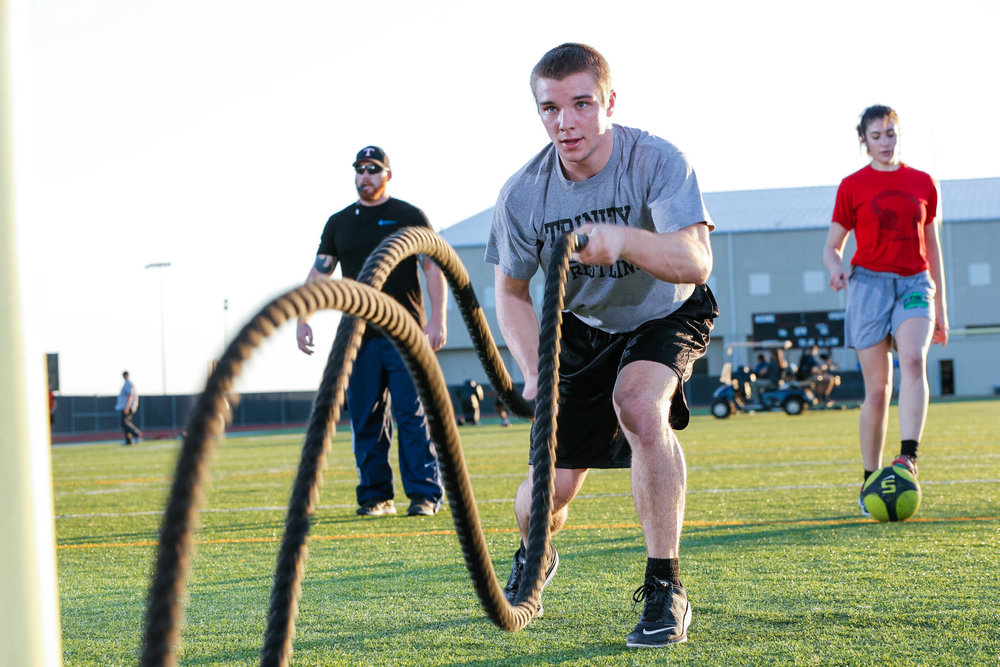Exercise Daily – Are you looking to boost your athletic performance and take your fitness journey to the next level? High-Intensity Interval Training (HIIT) might be the game-changer you’ve been searching for. In this article, we will unveil the realm of HIIT, exploring its benefits and how it compares to traditional training and providing you with a comprehensive guide on getting started and optimizing your athletic prowess.
1. HIIT
High-intensity interval Training, commonly known as HIIT, has taken the fitness world by storm due to its effectiveness in achieving fitness goals in less Time.
i. What is HIIT?
HIIT is not just another fitness trend; it’s a well-researched and proven workout strategy. At its core, HIIT involves alternating between short bursts of high-intensity exercises and brief periods of rest or low-intensity activity. These intense intervals push your body to its limits, making your heart rate soar and muscles work hard. It’s like sprinting and then walking repeatedly for a set duration.
The beauty of HIIT lies in its adaptability. You can tailor HIIT workouts to your fitness level and goals. Whether you’re a beginner or an experienced athlete, HIIT can be customized to challenge you appropriately.
2. Benefits of HIIT
Now, let’s explore why HIIT has become so essential in fitness routines:
i. Elevate Your Calorie Burn
One of the primary reasons people turn to HIIT is its ability to torch calories. The intense bursts of activity elevate your metabolism, leading to calorie burn even after your workout. This phenomenon, known as excess post-exercise oxygen consumption (EPOC), means you keep burning calories long after you’ve left the gym.
ii. Improve Cardiovascular Health
HIIT has a profound impact on your heart health. It enhances your cardiovascular fitness by increasing your heart rate during the intense intervals. Over Time, this can lead to a stronger heart, lower blood pressure, and improved circulation. Your body becomes more efficient at delivering oxygen to your muscles, which can boost overall stamina.
iii. Save Time
In today’s busy world, Time is a precious commodity. HIIT workouts are designed to be short and sweet, making them ideal for those with a tight schedule. You can complete a highly effective HIIT session in as little as 20-30 minutes, making it easier to stay consistent with your workouts.
iv. Versatility
HIIT is incredibly versatile. You can incorporate many exercises into your routine, from bodyweight exercises like burpees and jumping jacks to equipment like kettlebells or stationary bikes. This variety keeps your workouts engaging and prevents boredom.
v. Fat Loss
If shedding excess body fat is your goal, HIIT is a powerful tool. It helps you maintain lean muscle mass while burning fat, resulting in a more toned and sculpted physique. Plus, HIIT can target stubborn areas, such as belly fat.
vi. Suitable for All Fitness Levels
Contrary to the misconception that HIIT is only for elite athletes, it can be tailored to any fitness level. Beginners can start with shorter, less intense intervals and gradually increase the intensity as they progress.

3. HIIT vs. Traditional Training
In the realm of fitness, the battle between High-Intensity Interval Training (HIIT) and traditional training methods is a topic of great interest.
i. How HIIT Differs from Traditional Workouts
To truly understand the distinction between HIIT and traditional training, we must unravel their core characteristics:
Duration and Intensity
HIIT workouts are renowned for their brevity and intensity. They involve short bursts of all-out effort, typically lasting anywhere from 20 seconds to 2 minutes, followed by brief periods of rest or low-intensity recovery. In contrast, traditional workouts often involve sustained, moderate-intensity exercise for longer durations, such as 30 minutes to an hour.
Calorie Burn
HIIT takes the crown regarding calorie burn during and after the workout. The high-intensity intervals push your body to its limits, significantly increasing calorie expenditure. Moreover, the post-workout calorie burn continues for hours, thanks to the EPOC effect. Traditional workouts, while effective, may not deliver the same calorie-burning punch in a short timeframe.
Time Efficiency
One of HIIT’s major selling points is its time efficiency. A full HIIT session can be completed in a fraction of the time it takes to finish a traditional workout. This makes HIIT an attractive option for those with busy schedules or limited gym time.
Cardiovascular Benefits
Both HIIT and traditional training offer cardiovascular benefits, but they achieve them differently. HIIT rapidly elevates your heart rate during intense intervals, improving cardiovascular fitness efficiently. Traditional training, on the other hand, focuses on sustained, moderate-intensity exercise, which can also enhance cardiovascular health but may require longer sessions.
ii. Which is Better?
Now, the million-dollar question: Is HIIT superior to traditional training, or does it depend on individual preferences and goals?
HIIT Might Be Your Ideal Choice If…
- You have limited time for workouts but want maximum results.
- You enjoy variety and prefer shorter, more intense workouts.
- Weight loss is a primary goal, and you want to maximize calorie burn.
- You’re looking to improve cardiovascular health quickly.
- You appreciate workouts that challenge both your body and mind.
Traditional Training Could Be Your Go-To If…
- You prefer longer, less intense workouts.
- Building endurance or muscle mass is your primary goal.
- You’re recovering from an injury and need lower-impact exercise.
- You enjoy the steady rhythm of traditional workouts.
- You have more time available for fitness and can commit to longer sessions.
Ultimately, the choice between HIIT and traditional training comes down to your preferences, fitness goals, and lifestyle. Some individuals thrive on the intensity and efficiency of HIIT, while others prefer the endurance-building qualities of traditional training. It’s worth noting that a combination of both approaches can also be effective, allowing you to enjoy the best of both worlds.

4. Getting Started with HIIT
Now that we’ve uncovered the basics of High-Intensity Interval Training (HIIT) and compared it to traditional training, it’s Time to embark on your HIIT journey.
i. Setting Your Goals
Before you dive into HIIT, it’s crucial to define your fitness goals. Are you aiming for weight loss, improved cardiovascular health, muscle gain, or enhanced overall fitness? Your objectives will shape your HIIT routine.
Weight Loss
If your primary goal is shedding pounds, you’ll want to focus on HIIT workouts that maximize calorie burn. Short, intense sessions with minimal rest intervals are ideal.
Cardiovascular Health
For improving your heart health and endurance, opt for longer intervals and exercises that elevate your heart rate consistently throughout the workout.
Muscle Gain
If you’re looking to build muscle, consider incorporating resistance exercises, such as bodyweight exercises or weights, into your HIIT routine. Include strength-focused intervals.
Overall Fitness
To enhance your overall fitness level, create a well-rounded HIIT plan that includes cardio and strength exercises.
ii. Choosing the Right Exercises
HIIT workouts can include a wide variety of exercises, so you have the freedom to tailor your routine to your preferences and goals. Here are some popular exercises to consider:
Bodyweight Exercises
- Burpees
- Jumping jacks
- Mountain climbers
- Push-ups
- Squats
- Lunges
Cardio Exercises
- Running in place
- Jump rope
- Cycling (stationary or outdoor)
- Swimming (for advanced swimmers)
- Stair climbing
Strength Exercises
- Kettlebell swings
- Dumbbell or barbell exercises (e.g., thrusters, deadlifts)
- Medicine ball slams
- Resistance band exercises
Choose exercises that you enjoy and that align with your goals. Remember to include various exercises to target different muscle groups and engage your workouts.
iii. Creating a Workout Plan
Effortlessly create an effective HIIT workout plan by following these steps:
Warm-Up
Start with a 5-10-minute warm-up to prepare your body for the intense work. Incorporate dynamic stretches and light cardio, like jogging in place or jumping jacks.
Interval Structure
Decide on the structure of your intervals. For beginners, a 1:2 or 1:3 work-to-rest ratio is a good starting point. As you progress, you can decrease the rest intervals.
Exercise Selection
Choose 3-5 exercises for your HIIT routine. Perform each exercise for the specified work interval, followed by a rest interval. Repeat this cycle for the desired number of rounds.
Cool-Down
Finish your HIIT session with a 5-10 minute cool-down. Include static stretches to improve flexibility and reduce the risk of post-workout soreness.
Frequency
Determine how often you’ll do HIIT. For beginners, 2-3 sessions per week are sufficient. As you become more conditioned, you can increase the frequency.
Progression
Keep challenging yourself by increasing the intensity or duration of your HIIT sessions as your fitness improves. This can involve shorter rest intervals, more challenging exercises, or additional rounds.

5. Executing HIIT Workouts
Now that you’ve set your goals, chosen suitable exercises, and crafted a workout plan, it’s Time to execute High-Intensity Interval Training (HIIT) workouts with precision and effectiveness.
i. Warm-Up and Cool-Down
Warm-Up
Before diving into the high-intensity intervals, take 5-10 minutes to warm up your body. A proper warm-up prepares your muscles, joints, and cardiovascular system for the intense exercise. Here’s how to do it:
- Dynamic Stretches: Engage in dynamic stretches, which involve movement, to improve flexibility and range of motion. Examples include leg swings, arm circles, and hip rotations.
- Light Cardio: Incorporate light cardio exercises like jogging in place, jumping jacks, or brisk walking. Gradually increase the intensity to elevate your heart rate.
The HIIT Workout Routine
HIIT is characterized by short bursts of high-intensity exercise followed by brief periods of rest or low-intensity activity. Here’s a step-by-step guide on how to execute a HIIT session:
- Work Interval: Start with your chosen exercise and give it your all during the work interval. Perform the exercise as intensely as you can while maintaining proper form. The duration of the work interval depends on your fitness level and goals but typically ranges from 20 seconds to 2 minutes.
- Rest Interval: After the work interval, transition to a rest interval. During this period, you can rest completely or engage in low-intensity activities like walking or slow jogging. The rest interval should be shorter than the work interval, usually around half the duration.
- Repeat: Repeat the work-rest cycle for the desired number of rounds. Beginners may start with 3-4 rounds, while more advanced individuals can aim for 6-8 rounds or more.
- Exercise Variety: If you’ve chosen multiple exercises for your HIIT routine, rotate through them in each work interval to target different muscle groups and keep the workout engaging.
- Intensity: Focus on giving your maximum effort during the work intervals. Your heart rate should soar, and you should feel challenged. As you progress, consider reducing the rest intervals or increasing the intensity of the exercises.
ii. The Importance of Cooling Down
After completing the high-intensity portion of your workout, it’s essential to cool down properly. Cooling down helps your body recover and reduces the risk of muscle soreness or injury. Here’s how to cool down effectively:
- Static Stretches: Perform static stretches to elongate and relax your muscles. Hold each stretch for 15-30 seconds, targeting the major muscle groups you’ve worked on during your HIIT session.
- Deep Breathing: Take a few minutes to practice breathing exercises to lower your heart rate and promote relaxation.
- Hydration: Rehydrate by drinking water or a sports drink to replace fluids lost during the workout.
6. Tracking Progress
Tracking your Progress in your High-Intensity Interval Training (HIIT) journey is essential to measure your improvements, stay motivated, and make informed adjustments to your workouts.
i. Importance of Tracking Progress
Why is tracking Progress so crucial in your HIIT endeavours? Here are several compelling reasons:
Motivation
Seeing tangible improvements, such as increased endurance, reduced rest times, or enhanced strength, motivates you to keep pushing yourself during HIIT workouts.
Goal Assessment
Regular progress tracking helps you assess whether you’re moving closer to your fitness goals. It allows you to make necessary adjustments to your workout plan if needed.
Preventing Plateaus
Plateaus can be discouraging. By monitoring your Progress, you can identify when your results start to plateau and implement changes to break through these barriers.
Safety
Tracking your Progress helps you ensure you’re not overtraining or pushing your body too hard, reducing the risk of injury.
ii. Tools for Tracking
There are various tools and methods available to help you track your HIIT progress:
Workout Journal
Keeping a workout journal allows you to record the details of each HIIT session, including the exercises, work and rest intervals, and how you felt during the workout. Over Time, you can review your journal to identify trends and improvements.
Fitness Apps
Numerous fitness apps are designed specifically for tracking HIIT workouts. These apps often provide timers, exercise logs, and progress graphs, making it easier to monitor your performance.
Heart Rate Monitors
A heart rate monitor can give you real-time data on your heart rate during HIIT sessions. This information can help you ensure you’re reaching the desired intensity levels and recovering adequately during rest intervals.
Fitness Trackers
Wearable fitness trackers can provide valuable data on your overall physical activity, including HIIT. They can track steps, calories burned, and heart rate, giving you a comprehensive view of your fitness progress.
Progress Photos
Regular photos of your body can visually document changes in your physique over Time. Sometimes, the scale doesn’t tell the whole story, but photos can reveal subtle improvements.
Performance Metrics
Please keep track of key performance metrics, such as the number of rounds completed, the duration of intense intervals, and the Time it takes to recover between intervals. Gradual improvements in these metrics indicate Progress.
Fitness Assessments
Periodically assess your fitness level through the beep test, 1-mile run, or body composition measurements. These assessments provide objective data on your overall fitness.
iii. Celebrate Achievements
Don’t forget to celebrate your achievements, no matter how small they may seem. Each improvement, whether an extra push-up, a shorter rest interval, or a decrease in your heart rate recovery time, is a step toward your fitness goals. Celebrating these milestones can boost your motivation and make your HIIT journey more rewarding.

7. Nutrition and Recovery
In your quest to maximize the benefits of High-Intensity Interval Training (HIIT), it’s essential to pay close attention to both nutrition and recovery. These two elements are often underestimated but play a significant role in achieving your fitness goals.
i. Fueling Your Body
Fueling your body with the right nutrients before and after HIIT workouts is essential for optimal performance and recovery. Here’s what you need to know:
Pre-Workout Nutrition
Before a HIIT session, focus on consuming a balanced meal or snack that includes:
- Carbohydrates: These provide the energy your body needs for intense exercise. Opt for complex carbs like whole grains, fruits, and vegetables.
- Protein: Protein helps repair and build muscle tissue. Lean sources like chicken, fish, beans, or plant-based options are excellent.
- Hydration: Ensure you’re well-hydrated before starting your workout. Dehydration can negatively impact your performance.
- Timing: Aim to eat your pre-workout meal or snack 1-2 hours before exercising to allow for digestion.
Post-Workout Nutrition
After a HIIT workout, your body needs nutrients for recovery. Focus on the following:
- Protein: Consume a source of protein to aid in muscle repair and growth. Whey protein shakes, lean meats or plant-based protein options are suitable.
- Carbohydrates: Replenish glycogen stores in your muscles by consuming carbohydrates. This helps with recovery and prepares you for your next workout.
- Hydration: Rehydrate by drinking water or a sports drink to replace fluids lost during exercise.
- Timing: Try to eat a post-workout meal or snack within 30 minutes to an hour after exercising to optimize recovery.
ii. Post-Workout Recovery
Proper recovery is just as crucial as the workout itself. Here’s how to facilitate recovery after a HIIT session:
Cool Down
After completing your HIIT workout, spend a few minutes doing light, low-intensity exercises and stretching. This helps reduce muscle soreness and promotes flexibility.
Stretching
Incorporate static stretching into your cool-down routine. Stretch the major muscle groups you’ve worked on during your workout, holding each stretch for 15-30 seconds.
Rest
Ensure you get adequate rest between HIIT sessions. Overtraining can lead to fatigue and an increased risk of injury. Aim for 48 hours of recovery between intense workouts targeting the same muscle groups.
Sleep
Prioritize sleep, as it is when your body undergoes significant repair and recovery processes. Aim for 7-9 hours of quality sleep each night.
Nutrition
As mentioned earlier, post-workout nutrition plays a vital role in recovery. Consume a balanced meal or snack with a focus on protein and carbohydrates.
Foam Rolling
Using a foam roller can help alleviate muscle tightness and soreness. Roll slowly over tight areas for 1-2 minutes per muscle group.
Hydration
Continue to hydrate throughout the day to replace fluids lost during your workout.
Listen to Your Body
Pay attention to how your body feels. If you experience excessive soreness or fatigue, consider adjusting your workout intensity or frequency.
8. Expert Tips
As you embark on your High-Intensity Interval Training (HIIT) journey to improve your athletic performance, you must have a solid foundation and guidance to maximize your success.
i. Consult a Fitness Professional
Seeking guidance from a fitness professional, such as a certified personal trainer, can be a game-changer in your HIIT journey. Here’s why it’s crucial:
- Customization: A fitness professional can tailor a HIIT program specifically to your fitness level, goals, and any unique considerations you may have, such as injuries or medical conditions.
- Form and Technique: Proper form and technique are vital to prevent injuries and maximize the effectiveness of your workouts. A trainer can provide hands-on guidance and corrections.
- Progress Tracking: They can help you track your progress, make necessary adjustments to your workouts, and keep you accountable.
- Motivation: Having a trainer can boost motivation and ensure consistency with your HIIT routine.
ii. Listen to Your Body
Listening to your body is a fundamental principle of safe and effective HIIT. Here’s how to do it:
- Rest When Needed: If you feel excessively tired or experience pain beyond normal muscle soreness, it’s okay to take a break or modify your workout.
- Avoid Overtraining: Overtraining can lead to burnout and injury. Be mindful of your body’s signals and allow for proper rest and recovery between sessions.
- Progress Gradually: Don’t rush into high-intensity workouts if you’re new to exercise or HIIT. Start at an appropriate level and gradually increase the intensity and duration as your fitness improves.
- Stay Hydrated: Dehydration can affect your performance and recovery. Drink water before, during, and after your workouts.
iii. Cross-Training
While HIIT is a powerful training method, incorporating variety into your fitness routine can yield additional benefits:
- Balance: Cross-training with different exercises, such as strength training, yoga, or low-impact cardio, can help you achieve a balanced physique and reduce the risk of overuse injuries.
- Prevent Plateaus: Mixing up your workouts prevents your body from adapting too quickly and hitting a plateau. It keeps your Progress steady and your workouts exciting.
- Injury Prevention: Different exercises target different muscle groups and movement patterns, which can help prevent imbalances and reduce the risk of injury.
iv. Nutrition and Hydration
Your diet plays a significant role in your HIIT success:
- Fuel Properly: Consume a balanced diet rich in carbohydrates, protein, and healthy fats to provide your body with the energy and nutrients it needs for HIIT workouts.
- Timing Matters: Consider your meal timing before and after workouts. Pre-workout: have a meal or snack 1-2 hours in advance. Post-workout, refuel with a combination of protein and carbs within an hour.
- Stay Hydrated: Proper hydration is crucial for performance and recovery. Drink water throughout the day, and consider a sports drink if you have intense sweat loss during workouts.

Conclusion
As we wrap up our journey through HIIT, you now possess the knowledge and tools to embark on a fitness adventure like never before. Elevate your athletic performance, shed those extra pounds, and enjoy a healthier, more vibrant life through the power of HIIT.
FAQs (HIIT to Improve Your Athletic Performance)
Q: Is HIIT suitable for everyone?
We address the common concerns about HIIT’s suitability for different fitness levels and ages.
Q: How often should I do HIIT?
Discover the optimal frequency for incorporating HIIT into your fitness routine.
Q: Can I do HIIT at home?
Explore the convenience of performing HIIT workouts in the comfort of your own home.
Q: What’s the ideal HIIT duration?
Unveil the recommended duration for HIIT sessions to achieve maximum benefits.
Q: Can HIIT replace traditional workouts?
We explore whether HIIT can be a complete replacement for traditional training methods.





